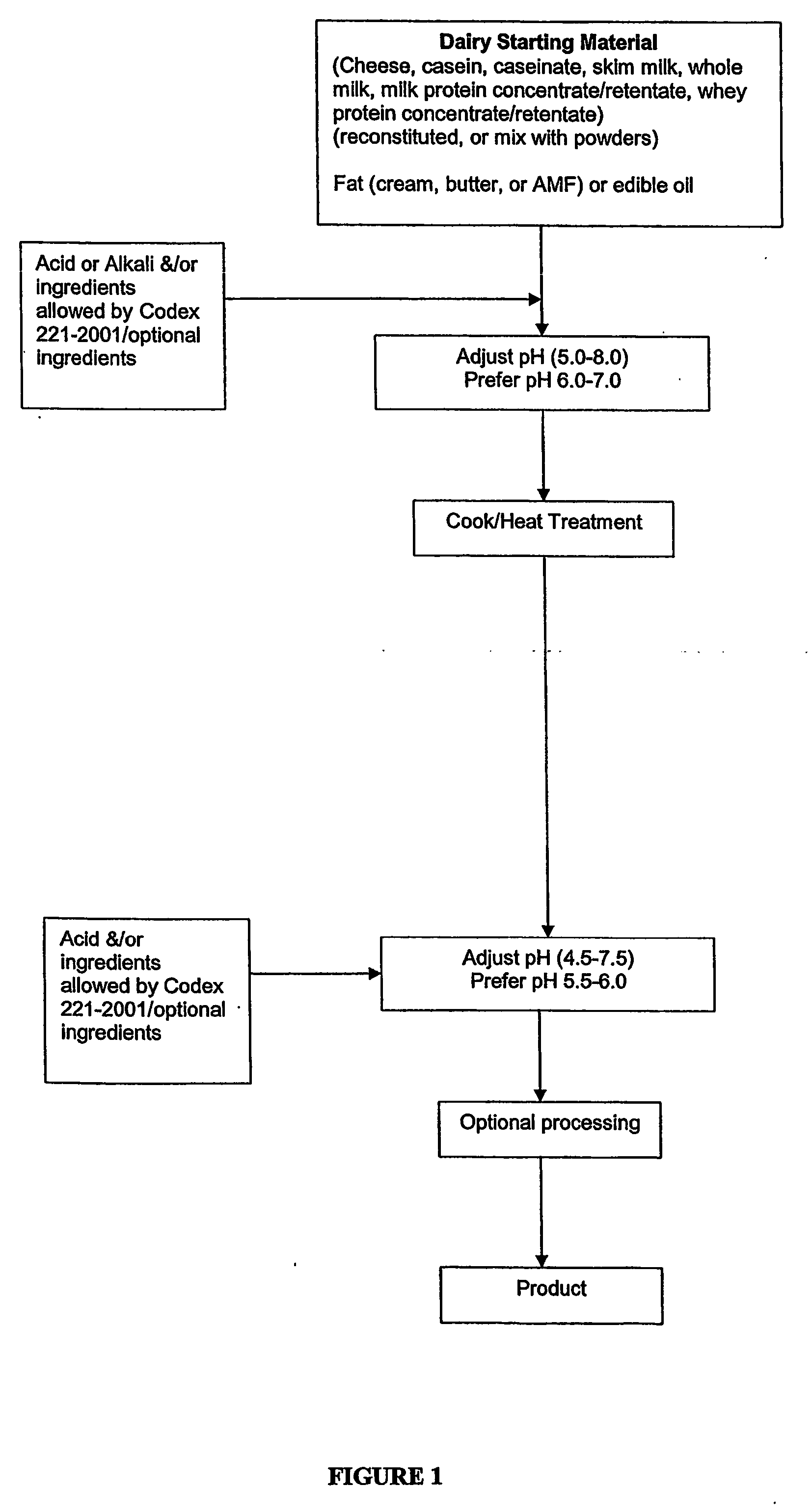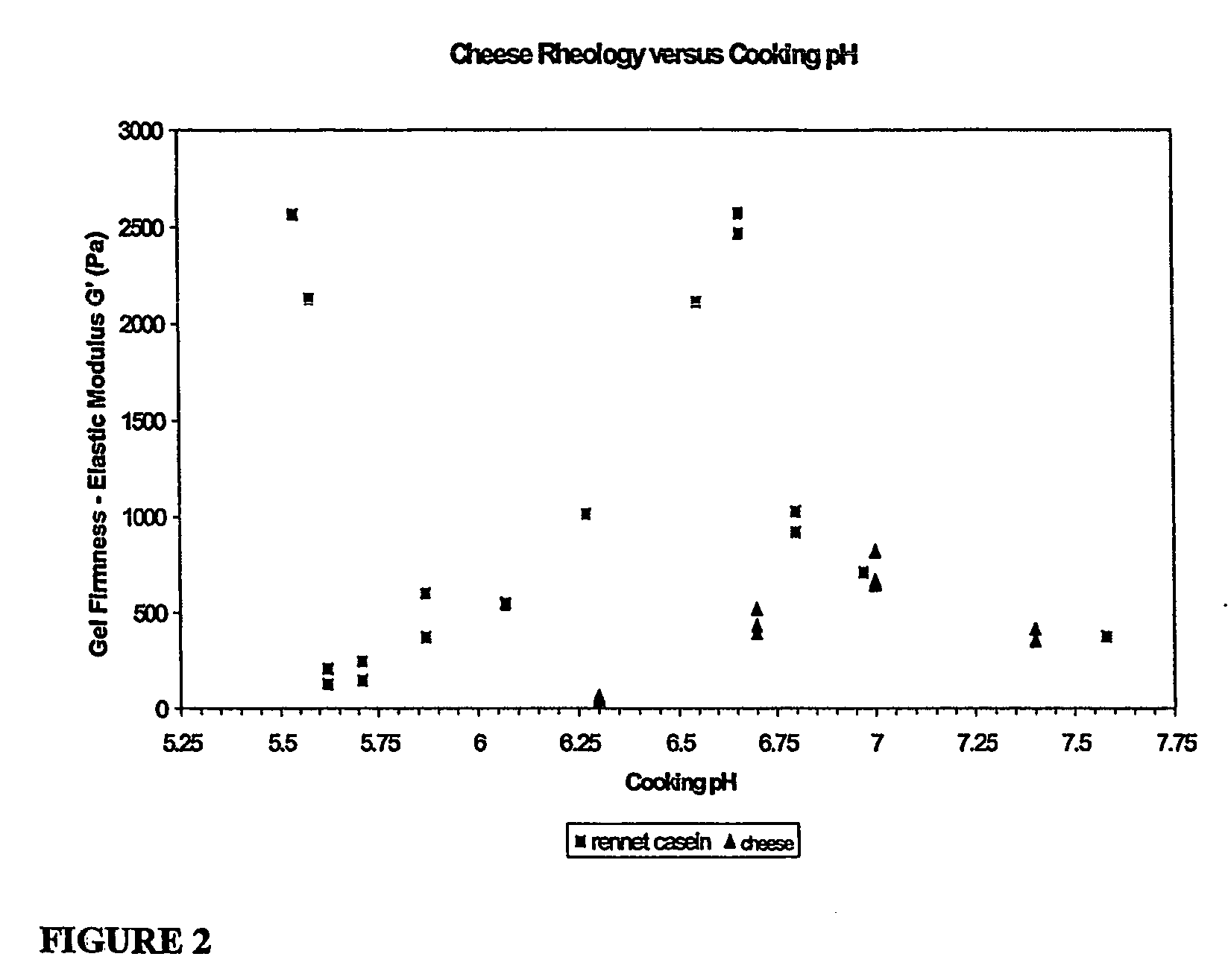Method for modifying the texture of a dairy product
a technology for modifying the texture of dairy products, applied in dairy products, cheese manufacture, animal protein working-up, etc., can solve the problems of inability to teach in-situ denaturation, small scope for independent manipulation of product texture, and inability to vary product texture, etc., to achieve good flavour, reduce cost, and improve product competitiveness
- Summary
- Abstract
- Description
- Claims
- Application Information
AI Technical Summary
Benefits of technology
Problems solved by technology
Method used
Image
Examples
example 1
A Gel Formulation Made from Cheese with the Texture of the Product being Varied Depending on the Cook pH
[0056]
IngredientWeight (g)Butter119.40Cheddar Cheese216.29WPC (ALACEN 392) 14.11Water223.29 (includes 7 g for evaporation)Sodium chloride 2.51Tri-sodium citrate 11.59Citric acid 1.332Total weight581.51
Preparation of Gel Samples—Generic Procedure Using Cheese
Sample 1
[0057] Equipment
[0058] The processed cheeses were prepared using a 2 L capacity Vorwerk Thermomix™ 21 blender cooker (Vorwerk & Co. Thermomix GmbH, Wuppertal, Germany).
[0059] Ingredients and Preparation
[0060] 14.11 g WPC (ALACEN 392, NZMP, Wellington, New Zealand) was dispersed in 61.88 g water and allowed to hydrate overnight at 4° C.
[0061] Butter (NZMP, Wellington, New Zealand) was heated for 1 min in the blender-cooker with the temperature setting at 100 and impellor speed setting 1 (100 rpm). This brought the melted butter temperature to around 60° C.).
[0062] Cheddar cheese [matured for >12 months] (NZMP, ...
example 2
Gel Formulations Using Rennet Casein with Texture Varied According to Cook pH
[0069]
IngredientWeight (g)Sunflower oil192Rennet casein 55.08WPC (ALACEN 392) 15.36Water306.64(includes allowance of 11 gfor evaporation)Sodium chloride 6.0Tri-sodium citrate 11.43Citric acid 3.57Total weight590.08
Preparation of Gel Samples—Generic Procedure Using Rennet Casein
Sample 1
[0070] Equipment
[0071] The equipment used was the same as for the cheese based gels.
[0072] Ingredients and Preparation
[0073] Rennet casein 55.08 g, (ALAREN 799, 90 mesh, NZMP, Wellington, New Zealand) was hydrated in a solution of 11.43 g tri-sodium citrate (BHD Laboratory Supplies, Poole, England), 1.66 g citric acid (BHD Laboratory Supplies, Poole, England), 6 g sodium chloride (BHD Laboratory Supplies, Poole, England) and 170 g water. (The whey protein / casein ratio was 0.28.) The hydration of the mixture occurred overnight at 4° C.
[0074] WPC (ALACEN 392, NZMP, Wellington, New Zealand) was dispersed in 67.64 g water...
example 3
Preparation of a Cream Cheese-Like Product
[0086] Preparation of a Cream Cheese Using Vorwerk Cooker
IngredientWeight (g)Anhydrous milk fat (AMF)193.185Rennet casein 45.792WPC (ALACEN 392) 25.44Water301.175(includes allowance of 11 gfor evaporation)Sodium chloride 6.36Tri-sodium citrate 12.879Citric acid 5.872Total590.703
[0087] The model cream cheese was prepared using a 2L capacity Vorwerk Thermomix™ 21 blender cooker (Vorwerk Australia Pty. Ltd., Granville, N.S.W., Australia).
[0088] The rennet casein (ALAREN 799, 90 mesh, NZMP, Wellington, New Zealand) was hydrated with sodium chloride, tri-sodium citrate (Jungbunzlauer GmbH, Perhofen, Austria) and 3.0 g citric acid (Jungbunzlauer GmbH, Perhofen, Austria) and 100 g of water and held overnight at 4° C. The WPC (ALACEN 392, NZMP Wellington, New Zealand) was hydrated in 60 g of water for half an hour at room temperature.
[0089] Frozen anhydrous milk fat, NZMP, Wellington, New Zealand after thawing at room temperatu...
PUM
 Login to View More
Login to View More Abstract
Description
Claims
Application Information
 Login to View More
Login to View More - R&D
- Intellectual Property
- Life Sciences
- Materials
- Tech Scout
- Unparalleled Data Quality
- Higher Quality Content
- 60% Fewer Hallucinations
Browse by: Latest US Patents, China's latest patents, Technical Efficacy Thesaurus, Application Domain, Technology Topic, Popular Technical Reports.
© 2025 PatSnap. All rights reserved.Legal|Privacy policy|Modern Slavery Act Transparency Statement|Sitemap|About US| Contact US: help@patsnap.com



